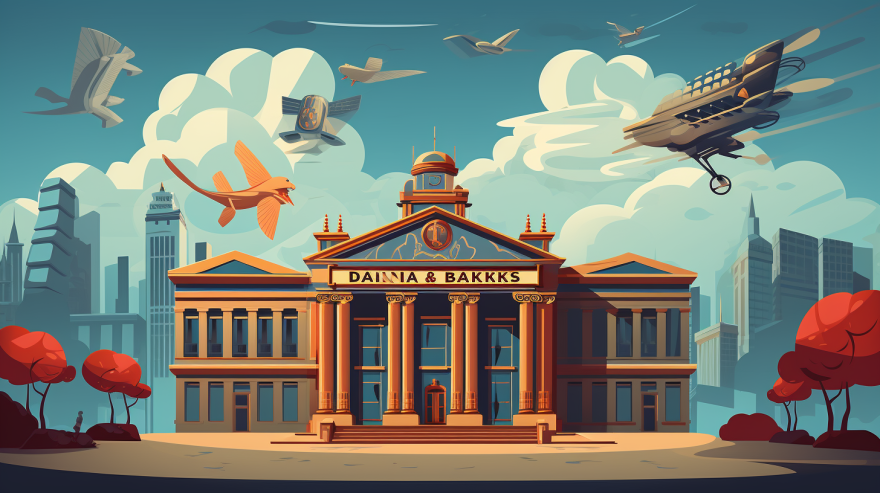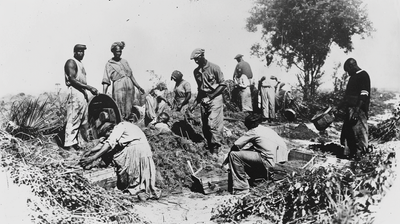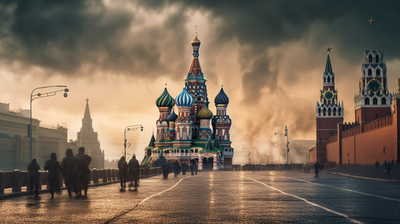Banking and Banks
Introduction
Banks...we love to hate them. Thanks to the financial crisis, banks have become a punchline in our modern era. But the reality is that people depend on them for their financial services. Most people have credit and debit cards, and others have banks held and managed by banks. They allow your employer to pay you each week or two weeks, allowing you to spend those funds in cash or over the Internet. They lend money to businesses so that they can expand without having to have the ready cash on hand. They allow for a sophisticated modern economy, giving them unprecedented power, as we all discovered in 2008. Banks are a part of our everyday lif,e but most banks don't have a recognizable brand that most people would recognize. Only a few banks, like Wells Fargo, Chase, Bank of America, and Capital One, have a significant national presence that people know about. There are other banks like, say, BNP Paribas, New York Mellon, Goldman Sachs, First Fifth, and others that are much less known. This doesn't even begin to touch clearing houses and other private or specialty banks that are an essential part of the economy and keep capital moving so that people have jobs and, in turn, spend that money on the things they need. Banking is an integral part of our lives, but most people don't know much about it or the history of it. Most importantly, people don't understand how much of our lives banks control because they hold the money.
Ancient Banks and Money
Ancient Babylon boasted the first institution that operated like a modern bank. People could deposit their grain at the bank and write checks against it. People could also get small loans. This type of banking would be standard throughout various ancient empires. The currency had to be stored, used for credit, and used for trade. The government issues the issuance of money but not in its storage or other business. This allowed temples and other companies to be the middle people who moved the wheels of the economy. However, banks and banking did not have a central role in most people's everyday lives. Most people, being poor subsistence farmers, did not need or use banks. These early banks catered primarily to traders and merchantmen who needed currency and who needed to borrow money for their various operations.
Temples were the first ancient banks. In the ancient world, temples were not a place to go to church or worship; they were the centers of society. A familiar story is Jesus driving the money changers out of the temple. In ancient Hebraic culture, money changing and other commerce was not allowed. The biblical myth of Jesus driving the money changers represented him attacking the pagan practice of money lending at the temple.
Temples were a place to change money, get a loan, buy needed supplies for worship, and conduct other temples. For temples, this was a vital source of needed cash for operations. For the community, it was a safe and trusted place to do business. The transactions were small, but the only place to organize and deploy capital. The Romans boasted the first institutional banks that were backed by law. Roman banking was expansive, especially with a single currency used across the empire, often in addition to other local currencies.
As antiquity ended and the first underpinnings of global trade began, banking for work became a big business, and one family in Florence would make a fortune that survives to this day in banking.

Medici
The first modern banks began in Florence. Banks would usually be chartered by the crown due in part to mercantilism, tight control of the economy, and regulation of anyone dealing with money. The infamous Medici family formed the first modern bank in 1397. At one time, called God's Banker, their wealth from banking brought the family into the highest echelons of power in Europe. The Vatican was a client with branches in almost every major European city. The family married into nobility, and Medici family members were in the Italian aristocracy until 1737. The family also produced two queens in France during the height of its power. Cosimo inherited an established bank and turned it into an international empire. They made the Florin, the currency of Florence, into the American dollar of its day. It was the reserve currency of the 14th and 15th centuries.
The modern banking system grew out of a simple problem for the aristocracy. Due to feudalism, the nobility was often land-rich but cash-poor. When it came time to finance significant expenditures like war, for example, raising funds on the tax revenues the landed aristocracy received as their annual income could be challenging. They needed to borrow money using those tax revenues as collateral, and that's the service that Medici Bank provided to its wealthy clients.
One of the ways banking expanded in a monetary-based economy was through lending to governments. This was pioneered by Giovanni di Bicci de Medici, who founded the Medici bank—using his tremendous fame to finance a variety of art in 13th-century Florence. Later generations of the Medici family became patrons of the arts. The conspiracies around the family and their banks are legendary in the Internet's shadows. The Medici family is an excellent example of the power of capital. Githeirnni expanded the fortune by loaning money to governments to fund civil projects and wars. This is where banking, capitalism, governments, and debt converge in a confluence of financial interests.
Cosimo used that wealth to patronage churches, the arts, and the sciences. Giovanni, the founder of the banking dynasty and his heirs, like Cosimo, created methods of banking and business that are still in use today, like double-entry bookkeeping and a basic credit system using letters of credit and currency exchange.
The Medicis were often, both at the time and in history, referred to as the true rulers of Europe because they controlled the flow of capital around the continent. King in all but name, as one Pope put it. Their power lasted long after the bank collapsed in 1494. The bank collapsed until a new version, still owned by the family, popped up in Puerto Rico in 2019, and the Medici's influence in Renaissance Europe continued. The Medicis invented modern banking to a point where other civilizations were getting in on storing money for trade.
The Chinese introduced the world's first paper money in 960 under the Song dynasty. From that point onward, China had small banks for commerce, larger banks for government services, and large traders. China did not develop an international profile in banking until the late 20th century, as China was closed to foreign trade until the late 19th century. China has a unique culture in banking and finance because of its legal culture. Unlike the West, business in China is less about the law and solving problems in the court and more about the networks of intimate personal relationships and friendships between the people involved in the companies. If a bank didn't trust a trader, there was almost nowhere he could do business. He couldn't simply cross the street and go to another bank. He would have to begin again by developing a personal relationship with the bank's owner. Trust takes years to build. This also often kept competition to a minimum. Even today, business in China operates far more on personal relationships than on China's legal framework. Banks in China are state-owned, despite the opening of China's economy in 1989.
Banking, as such, would continue in Europe on the Medici model, which would become the basis of the modern banking system. The fact that they were so powerful without having any title in Church or State shows just how powerful capital can be. When you control the money, you care less who makes the laws. Remember that, because it's going to be necessary.

Banking in America
At the founding of the United States, Alexander Hamilton promoted the idea of a national bank to make loans and provide a common currency for the new republic. Many other Founding Fathers, like Madison and Adams, were not interested in financial institutions having that much power. Still, the Bank of the United States operated until 1836, when Andrew Jackson abolished it.
It was clear to the founders that bankers were an influential part of society; they broadly wanted to prevent bankers from having more power than "the people" (in this case, white, landed gentry like themselves). They did not wish the young republic to be immediately drowned in debt on easy terms from a central bank that could influence policy. There was also the matter of the federal government becoming debt to bankers—1811 when the first bank came up for renewal, it was narrowly defeated. When the republic couldn't finance the War of 1812, Congress chartered another bank in 1816. The central bank would be a contentious issue in the middle of the century. Andrew Jackson was stridently against a central bank, hence his abolition when its charter was reviewed. The United States would not have a central bank again until the founding of the Federal Reserve System in 1913.
State governments often also increased proliferated throughout. As the Industrial Revolution took hold in the new republic, banks, paper currency, and other services like loans became essential to the economy. However, the earliest American banks (like the Bank of North America and the Bank of New York) were not a part of any centralized system. They were independent and depended on their capitalization to survive.
This led to problems. Financial panics rocked the country throughout the 19th century. However, the need for a central bank became important again after a series of financial panics that had devastating economic consequences between 1895 and 1907.
Banks in the 19th censored their paper bank instead of used instead of the actual currency still held in their banks. When these were used for trading, anyone having them could return to the bank in question and retrieve the same value they kept in a paper in silver or gold. This also meant that the US had no central paper currency. If a bank went under, then the paper currency was worthless. Banks would be liquidated, and all their deposits would go to anyone with a liability at the bank. There was no deposit insurance of any kind and no way banks could easily borrow from each other or a central force to cover too many customers taking their money out all at once. If rumour got around that a bank was in trouble, a run on the bank could occur with people coming in demanding their money.
The Federal Reserve was supposed to stop all the problems. By creating a network of interbank lending that a central bank managed, these sorts of bank runs, financial panics, and unregulated currency were all supposed to end. It did, in principle. However, things like deposit insurance wouldn't become standard until after another great financial crisis: The Great Depression.

The Great Depression
The Great Depression started when the value of Stocks in the stock market began to fall due to an untimely sell-off. Taken people had loans against their stocks, and soon, margin calls, people asking for more money to secure the loan against a falling asset, ruined people financially by sucking up their cash on hand. People getting laid off and needing cash led to people pulling money out of banks. Banks don't keep your money; they loan it and support only a tiny fraction. It's called fractional reserve banking, and I'll explain more about that in a moment.
The Federal Reserve was supposed to stop this. Still, the problem was so big, and the amount of money needed so great the Federal Reserve could not meet demand, and indeed, they decisively chose not to meet demand for new funds to keep banks capitalized fully. Markets collapsed,d and people suddenly found that they had no job, no cash, and employers who could not pay them. Rather than turn on the spigots of money, the Federal Reserve and Andrew Mellon raised interest in 1933 and caused a double-dip recession, leading to the lowest days of the Depression.

Financial
Banking is the foundation of modern capitalism as we know it. Capitalism would be nothing without banks and banking. Banking is the backbone of the contemporary global economy. Banks handle payments, store wealth, and provide trillions of dollars in loans to corporations to produce goods and services and to the government to finance state affairs. Ancient Greece is an ancient system of storing wealth from ancient Babylon, where banks used grain as a currency.
Until the 20th century, most banned their currency and exchanged it between themselves or a national currency. However, this led to unreliable currencies, and people were often left with nothing if the bank failed and the resulting money became worthless. Centralized, government-backed coins became far more reliable and straightforward than actual gold, silver, or the bank-issued currency backed by Monsters. Most currencies are printed by central banks and backed by a national government. Central banks also provide security for smaller banks by allowing them to freely borrow money to stay solvent without destroying the savings and wealth of depositors.
Along the way, as wealth grew, banks went from small, local, and regional institutions to global powerhouses of capitalism with investments in locations worldwide. This ability was made possible by globalization and the global flows of capital. At first glance, it seems attractive. Capital seeks places for a return; companies and banks look for places to create return, value, and growth. New markets for goods and services are prime locations for this. Countries that need capital to begin their industries are also places for increased chances of return. The Asian Financial Crisis (triggered by the collapse of the Thai Baht) and the South American bank failures (triggered by a variety of problems stemming from socialist governments to bad investments) have shown that this pathway is fraught with difficulties, and those difficulties are frequently shouldered by people thousands of miles away from the problem.
Banks are an integral part of the equation when it comes to powering the industrial means of production. Companies borrowed the massive cash that was needed upfront to fund production. When buying machines, building facilities, and other capital-intensive projects, banks were on the front line of investing in that they could pay back the loaned money with interest. This was the first rudimentary form of capitalist practices. Banks invested in projects they thought had a good chance of making them money because their source of capital was the depositors of the banks. When people deposit money into banks, banks aren't merely keeping that money out of convenience; they invest it via loans to companies for a return. Then, from the interest they have made (that's the return), they give you an amusing for using your money and keep the rest for themselves. Savers who leave money in a savings account for 30 or more days receive a small amount of interest because they have borrowed that money and earned a draw from it.
Banks also make money from the government by loaning the government money and earning interest off of that, too. They also often handle transactions alongside the government like they used to with student loans and home mortgages. The finances of any sophisticated economy are tied to the banks. So how do they work?
How Banks Work
Fractional Reserve Banking
Before we look at modern banking, we must consider how modern banks and money works. Unlike the relatively simple transactions of taking deposits and loaning out money like banks of the past, modern banking is much more sophisticated. When you open a bank account, the bank holds in reserve about 10% and then takes the rest and makes it available to loan out. It's still in your account, and you can still access and spend it, but the bank is already using that money to make another loan to someone else. This can be a credit card, business loan, or whatever loan you like. Banks also sometimes use these assets to make investments.

Investment banks
In 2008, we all got an education on investment banks. Investment banks are different than the retail banks you likely use. These banks don't just make loans from their companies; they provide a product or service and make a return. These banks also create sophisticated financial products and sell them to investors. They also will handle stock and bond transactions for clients.
Credit Unions
There is another kind of ATM (I'm being pornographic). It's usually a bank; it's a credit union. I found them in 2014 when I first started The Cameron Journal. They were created during the Depression and owned by the members who would have money on deposit there, and then the credit union would loan out that money to other members who needed it. Credit unions are a marriage; it's a group of people who own and control their financial institutions. Institutions are big companies, usually local, and are limited in size by regulations. The deposits are a separate sort of insurance company controlled by the government.
Banks for banks
Three types of banks handle banking for banks: Clearing houses for transactions, Overnight loans for interbank lending, and money transfers. These banks only deal with other banks and don't do any interactions with the general public.

The GFC
Changes in financial regulations coming in the 1980s allowed banks to expand rapidly and find new ways to lend money, write mortgages, and encourage consumer spending with a disregard for the more significant macroeconomic consequences. All the guardrails set up during the Great Depression were removed in the name of greed. The best part was that they could make billions of dollars doing it, and in the case of mortgages, do it with securities that the federal government guaranteed. Banks began investing for themselves and taking on investment clients, which previous banks were not allowed to do. Investment and regular banks were kept separate to protect depositors, but those lines soon blurred in the 1980s.
This change in banking regulation did not happen overnight but in a series of small changes over time. One of the best ways to learn about this change is the introduction of the Oscar-nominated film The Big Short. Banks went from sleepy institutions that loaned money and kept people's money safe to high-flying places that steered the engine of global growth. This banking de-regulation eventually manifested in the financial crisis, as the highly sophisticated credit structures collapsed.
Probably the most significant financial meltdown since The Great Depression, The Great Financial Crisis was for the United States what the Asian Financial Crisis did to Asia, particularly Japan. Japan had already had a real estate bubble burst in 1991, and the Asian Financial Crisis doubled down the recession in 1997. Japan didn't recover from the AFC until it was just in time for the GFC. The GFC was so significant we're still talking about it. Multiple movies have been made about the events that began when the price of housing in specific markets started to fall in 2007, leading to a full-on banking crisis in 2008.
The federal government bailed out the banks and other institutions like AIG insurance company with $700 billion in TARP funds and $80 Billion just for AIG. How did these banks grow so large that McDonald's franchises worried that Bank of America wouldn't run their payroll at specific points in September and October 2008?
Banks, Banking, and You
I would argue that no institution in the country significantly affects our everyday lives more than banks. More so than politicians, banks have been empowered to become Masters of the Universe and create and destroy entire markets with the same shareholder value. Jobs and housing can be gained and lost at the whim of bankers. This gives them an outsized power that is genuinely frightening. Regulation is hard to come by in today's modern environment. As the Pandemic and the GFC showed, corporations and banks will get what they want. Banks had ten years of cheap and easy money leading in the Pandemic and another $5 trillion. The rich became much richer despite everything else, while others suffered a complete loss of their business and capital. It's good to be the bank, at least sometimes. Recently, there have been a series of bank failures. Yet again, in the case of Silicon Valley Bank and others, the government stepped in to rescue the depositors above the regulatory amount and solved the problem by shoving taxpayers' dollars at it. The banking system doesn't work for us, now does it?
institutions






